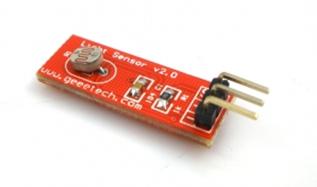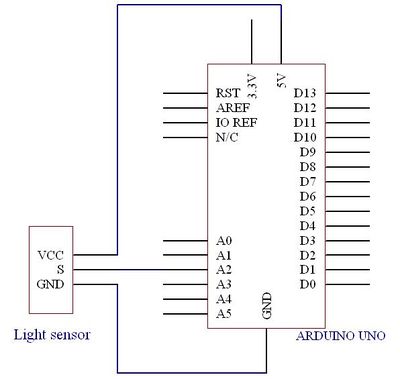Difference between revisions of "Mini Light Sensor"
(Created page with " == Introduction == The Light Sensor brick Module is based on photoresistor, It measures the environment light intensity and input data to Arduino through the analog IO port o...") |
(→Example code) |
||
| (7 intermediate revisions by the same user not shown) | |||
| Line 1: | Line 1: | ||
== Introduction == | == Introduction == | ||
| + | [[File:Light sensor.jpg]] | ||
| + | |||
The Light Sensor brick Module is based on photoresistor, It measures the environment light intensity and input data to Arduino through the analog IO port of Sensor Shield. Great tool for light following robot, gardening system or home alert system. | The Light Sensor brick Module is based on photoresistor, It measures the environment light intensity and input data to Arduino through the analog IO port of Sensor Shield. Great tool for light following robot, gardening system or home alert system. | ||
Building interactive work is as easy as piling bricks, just plug it to Arduino Sensor Shield with a buckled cable, and make it looks professional and neat | Building interactive work is as easy as piling bricks, just plug it to Arduino Sensor Shield with a buckled cable, and make it looks professional and neat | ||
| + | |||
== Technical Specifications: == | == Technical Specifications: == | ||
A photoresistor or light dependent resistor is a resistor whose resistance decreases with increasing incident light intensity; in other words, it exhibits photoconductivity. It can also be referred to as a photoconductor or CdS device, from "cadmium sulfide," which is the material from which the device is made and that actually exhibits the variation in resistance with light level. Note that although CdS is a semiconductor, it is not doped silicon. | A photoresistor or light dependent resistor is a resistor whose resistance decreases with increasing incident light intensity; in other words, it exhibits photoconductivity. It can also be referred to as a photoconductor or CdS device, from "cadmium sulfide," which is the material from which the device is made and that actually exhibits the variation in resistance with light level. Note that although CdS is a semiconductor, it is not doped silicon. | ||
| Line 18: | Line 21: | ||
*solar road studs | *solar road studs | ||
| − | == | + | ==Wiring diagram== |
| + | [[File:Light sensor2.jpg|400px]] | ||
| − | + | == Example code == | |
| − | |||
| − | void setup() { | + | int sensorPin = 2; |
| + | int value = 0; | ||
| + | void setup() { | ||
Serial.begin(9600); | Serial.begin(9600); | ||
| − | } | + | } |
| − | + | void loop() { | |
| − | void loop() { | ||
value = analogRead(sensorPin); | value = analogRead(sensorPin); | ||
Serial.println(value, DEC); | Serial.println(value, DEC); | ||
delay(50); | delay(50); | ||
| − | } | + | } |
| − | |||
== How to buy == | == How to buy == | ||
Click here to buy [http://www.geeetech.com/arduino-light-sensor-module-p-338.html Light Sensor] | Click here to buy [http://www.geeetech.com/arduino-light-sensor-module-p-338.html Light Sensor] | ||
Latest revision as of 02:19, 26 June 2012
Contents
Introduction
The Light Sensor brick Module is based on photoresistor, It measures the environment light intensity and input data to Arduino through the analog IO port of Sensor Shield. Great tool for light following robot, gardening system or home alert system.
Building interactive work is as easy as piling bricks, just plug it to Arduino Sensor Shield with a buckled cable, and make it looks professional and neat
Technical Specifications:
A photoresistor or light dependent resistor is a resistor whose resistance decreases with increasing incident light intensity; in other words, it exhibits photoconductivity. It can also be referred to as a photoconductor or CdS device, from "cadmium sulfide," which is the material from which the device is made and that actually exhibits the variation in resistance with light level. Note that although CdS is a semiconductor, it is not doped silicon.
A photoresistor is made of a high resistance semiconductor. If light falling on the device is of high enough frequency, photons absorbed by the semiconductor give bound electrons enough energy to jump into the conduction band. The resulting free electron (and its hole partner) conduct electricity, thereby lowering resistance.
Typical Application
- camera light meters
- street lights
- clock radios
- alarm devices
- outdoor clocks
- solar street lamps
- solar road studs
Wiring diagram
Example code
int sensorPin = 2;
int value = 0;
void setup() {
Serial.begin(9600);
}
void loop() {
value = analogRead(sensorPin);
Serial.println(value, DEC);
delay(50);
}
How to buy
Click here to buy Light Sensor

